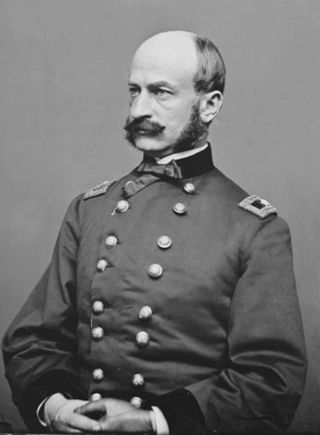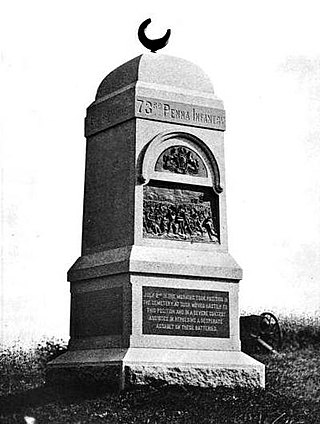
The XI Corps was a corps of the U.S. Army during the American Civil War, best remembered for its involvement in the battles of Chancellorsville and Gettysburg in 1863. The corps was composed primarily of German-American regiments.

There were five corps in the Union Army designated as II Corps during the American Civil War. These formations were the Army of the Cumberland II Corps commanded by Thomas L. Crittenden from October 24, 1862, to November 5, 1862, later renumbered XXI Corps; the Army of the Mississippi II corps led by William T. Sherman from January 4, 1863, to January 12, 1863, renumbered XV Corps; Army of the Ohio II Corps commanded by Thomas L. Crittenden from September 29, 1862, to October 24, 1862, transferred to Army of the Cumberland; Army of Virginia II Corps led by Nathaniel P. Banks from June 26, 1862, to September 4, 1862, and Alpheus S. Williams from September 4, 1862, to September 12, 1862, renumbered XII Corps; and the Army of the Potomac II Corps from March 13, 1862, to June 28, 1865.

Baron Adolph Wilhelm August Friedrich von Steinwehr was a German-Brunswick army officer who emigrated to the United States, became a geographer, cartographer, and author, and served as a Union general in the American Civil War.

Leopold von Gilsa was a career soldier who served as an officer in the armies of Prussia and later the United States. He is best known for his role in the misfortunes of the XI Corps in the Army of the Potomac during the American Civil War, particularly at the battles of Chancellorsville and Gettysburg, where many of his men were unjustly accused of cowardice.
The 25th Ohio Infantry Regiment was an infantry regiment in the Union Army during the American Civil War.
The 107th Ohio Infantry Regiment, sometimes 107th Ohio Volunteer Infantry was an infantry regiment in the Union Army during the American Civil War. It was also known as the 5th German Regiment.
The 5th Connecticut Infantry Regiment was an infantry regiment that served in the Union Army during the American Civil War.
The 17th Connecticut Infantry Regiment was an infantry regiment that served in the Union Army during the American Civil War.

The 93rd New York Infantry Regiment was an infantry regiment in the Union Army during the American Civil War.

The 76th New York Infantry Regiment was an infantry regiment in the Union Army during the American Civil War.

The 95th New York Infantry Regiment was an infantry regiment in the Union Army during the American Civil War.

The 94th New York Infantry Regiment was an infantry regiment in the Union Army during the American Civil War. The regiment has the distinction of being the last volunteer infantry regiment to muster out of the Army of the Potomac.

The 12th New York Infantry Regiment was an infantry regiment in the Union Army during the American Civil War.

The 86th New York Infantry Regiment was an infantry regiment in the Union Army during the American Civil War.

The 60th New York Infantry Regiment was an infantry regiment in the Union Army during the American Civil War. The regiment saw service in both the eastern and the western theaters of the American Civil War.

The 73rd Pennsylvania Volunteer Infantry was an infantry regiment that served in the Union Army during the American Civil War.
The 143rd Pennsylvania Volunteer Infantry was an infantry regiment that served in the Union Army during the American Civil War.
The 27th Pennsylvania Volunteer Infantry was an infantry regiment that served in the Union Army during the American Civil War.
The 29th Pennsylvania Volunteer Infantry was an infantry regiment that served in the Union Army during the American Civil War.
Battery I, 1st New York Light Artillery Regiment was an artillery battery from New York state that served in the Union Army during the American Civil War. The battery was organized in October 1861. It fought at Cross Keys and Second Bull Run in 1862. Battery I fought at Chancellorsville, Gettysburg, and Chattanooga in 1863. It participated in the Atlanta campaign and Sherman's March to the Sea in 1864 and fought at Bentonville in 1865. The battery took part in the Grand Review of the Armies and was mustered out in June 1865.







